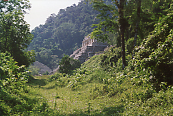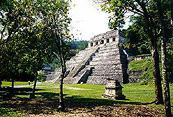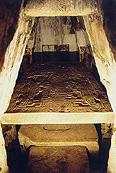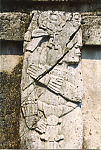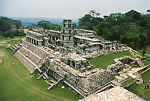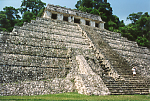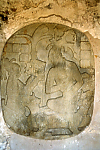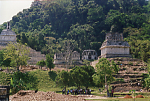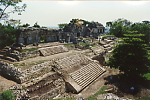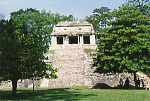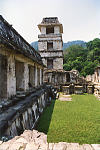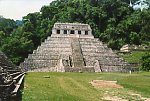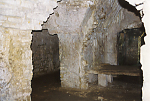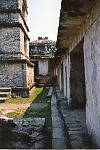 It
is difficult writing about the ruin sites, other than to describe the number
of temples, mounds, plazas or tombs. Palenque is small compared to grander
ruins like Copán, but still holds a quality in common with almost all the
sites I have seen. Sitting on temple steps or walking through mazes of
crumbling rooms, I have felt an energy that exists nowhere else. The word
"magical" has often referred to that quality for lack of a better
description, but this overused catchword is insufficient. When I visit a
site, impressions of populations, commerce and activity seep into the
periphery of my senses. Images rise-- plazas filled with isles of vendors
sitting on mats or cloth, selling everything from pyramids of polished
fruits and vegetables, mounds of herbs and medicinal remedies, baskets of
beans, rice or other staples, to cooking utensils and tools. The air is
slightly smoky from charcoal and wood fires and the smells of freshly cooked
food, livestock, dust and crowds. There are processions of priests and
politicians, incense, drums and flutes. These images always rise, like
holograms. It
is difficult writing about the ruin sites, other than to describe the number
of temples, mounds, plazas or tombs. Palenque is small compared to grander
ruins like Copán, but still holds a quality in common with almost all the
sites I have seen. Sitting on temple steps or walking through mazes of
crumbling rooms, I have felt an energy that exists nowhere else. The word
"magical" has often referred to that quality for lack of a better
description, but this overused catchword is insufficient. When I visit a
site, impressions of populations, commerce and activity seep into the
periphery of my senses. Images rise-- plazas filled with isles of vendors
sitting on mats or cloth, selling everything from pyramids of polished
fruits and vegetables, mounds of herbs and medicinal remedies, baskets of
beans, rice or other staples, to cooking utensils and tools. The air is
slightly smoky from charcoal and wood fires and the smells of freshly cooked
food, livestock, dust and crowds. There are processions of priests and
politicians, incense, drums and flutes. These images always rise, like
holograms.
 The
main plaza at Palenque lies on flat ground cradled up against dense,
jungle-covered hills. Away from this plaza, a group of small temples called
the Group of The Cross adorns tiny hills. The plaza itself consists of the
massive Temple of the Inscriptions and the Palace, a large complex of
buildings and the four-storied Palace Tower surrounding several courtyards.
The main area of the site also contains a ball court, a section called the
North Group, and a few unnamed structures. The
main plaza at Palenque lies on flat ground cradled up against dense,
jungle-covered hills. Away from this plaza, a group of small temples called
the Group of The Cross adorns tiny hills. The plaza itself consists of the
massive Temple of the Inscriptions and the Palace, a large complex of
buildings and the four-storied Palace Tower surrounding several courtyards.
The main area of the site also contains a ball court, a section called the
North Group, and a few unnamed structures.
(A couple of days ago, a young naked Mayan
man threw himself from the Tower to his death because, they say, he had
ingested some hallucinogen and thought he could fly. Another traveler named
Kelly witnessed the senseless tragedy and is still shaken by it.)
 Deep
within the center of the Temple of the Inscriptions is the spectacular tomb
of Pakal, one of the most important rulers of Palenque. It rests at the
bottom of a steep, dimly lit flight of about 75 damp and mossy stairs. The
actual sarcophagus in which he is buried is a plain, one-piece, solid
rectangular mass about 5 by 10 feet square and 4 feet thick. The body is laid in a
mummy's-coffin shaped hole in the center of this gigantic stone. After the
body was interred, the cut "lid" was put back in place like a cork, which is
flush with the stone's surface. When this lid was in place, a massive, flat
piece of rock about 7 by 12 feet in area and 12 inches thick, which is wider on all sides than the burial
stone, was laid on top, creating what looks like an enormous table.
The surface of this table-top-like stone is carved with exquisite, intricate
designs. The large central design is a bas-relief wherein the reborn Pakal is
figured with symbols of the afterlife in the Mayan cosmology. Around
the edges, within a wide border, are glyphs that record events in the life
of the king. It is the most elaborate I have actually seen yet, and the
surface of the carved stone is in near perfect condition. This is
history in intensely elegant art by consummate artisans. Deep
within the center of the Temple of the Inscriptions is the spectacular tomb
of Pakal, one of the most important rulers of Palenque. It rests at the
bottom of a steep, dimly lit flight of about 75 damp and mossy stairs. The
actual sarcophagus in which he is buried is a plain, one-piece, solid
rectangular mass about 5 by 10 feet square and 4 feet thick. The body is laid in a
mummy's-coffin shaped hole in the center of this gigantic stone. After the
body was interred, the cut "lid" was put back in place like a cork, which is
flush with the stone's surface. When this lid was in place, a massive, flat
piece of rock about 7 by 12 feet in area and 12 inches thick, which is wider on all sides than the burial
stone, was laid on top, creating what looks like an enormous table.
The surface of this table-top-like stone is carved with exquisite, intricate
designs. The large central design is a bas-relief wherein the reborn Pakal is
figured with symbols of the afterlife in the Mayan cosmology. Around
the edges, within a wide border, are glyphs that record events in the life
of the king. It is the most elaborate I have actually seen yet, and the
surface of the carved stone is in near perfect condition. This is
history in intensely elegant art by consummate artisans.
Palenque
commanded an area stretching miles and miles across a vast coastal plain
reaching as far as the Gulf of México. Backed by a lip of the moist, fecund
Chiapas Mountains, it was a sea of activity for tens of thousands of people
and a center of life and death-- another vortex of history, myth and
reality. To this day, the setting is magnificent and can easily
transport you across time, if only you take a moment to imagine.
|
